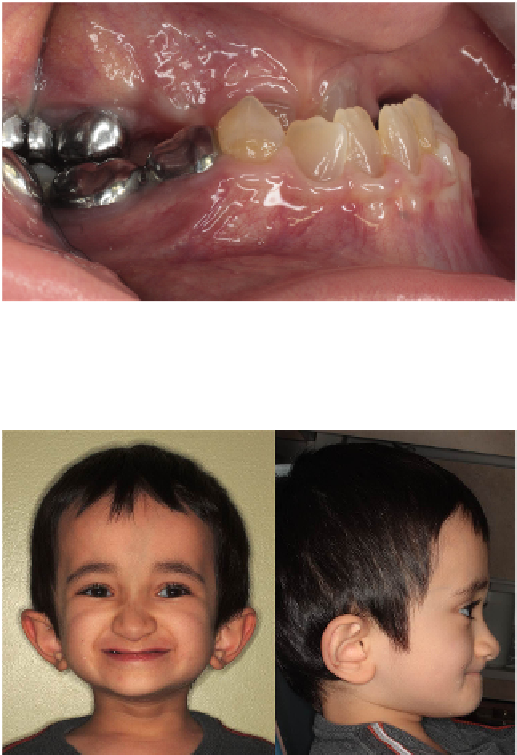what-when-how
In Depth Tutorials and Information
TABLE 33.1
Occlusal and Patient Characteristics in OI Affected
and unaffected Children from the montreal Children's Hospital
OI
n
=
49
Control
n
=
196
Gender
Males, n(%)
21 (42.9%)
84 (42.9%)
Age (mean ± SD), years
10.6 ± 3.2
10.6 ± 3.3
Age, n(%)
0-6 years
5 (10.2%)
20 (10.2%)
7-11 years
29 (59.2%)
116 (59.2%)
12-19 years
15 (30.6%)
60 (30.6%)
FIGURE 33.12
Intra-oral photo showing retrusion of the maxilla, for-
wards rotation of the mandible, anterior cross-bite (negative anterior over-
jet), and DI.
Molar relationship, n(%)
Class I
9 (18.4%)
131 (66.8%)
Class II
7 (14.3%)
56 (28.6%)
Class Ill
33 (67.3%)
7 (3.6%)
No Class
-
2 (1.0%)
OI Type, n(%)
I
8 (16.3%)
-
III
11 (22.4%)
-
IV
26 (53.1%)
-
V
2 (4.1%)
-
VI
2 (4.1%)
-
From Carbone C, Retrouvey JM, Mok E, Rauch F, Schwartz S. Occlusion in young
patients with osteogenesis imperfecta: a comparison to healthy children and adolescents.
In preparation for submission to the Angle Orthodontist journal.
This sample is in accordance with reports from the literature in regard to the increased
prevalence of Class III malocclusion (67%) in OI patients.
FIGURE 33.13
Eight-year-old male patient presenting with the
typical facial pattern associated with OI type III. Triangular face, boss-
ing of the forehead, low-set ears and maxillary retrusion.
anteroposterior dimension. It may be caused by the max-
illa being set back in sagittal relationship to the mandible,
or by a maxillary hypoplasia or deficiency, by a mandibu-
lar overdevelopment (prognathia) or by a combination of
effects on both jaws. This malocclusion is by far the least
common and affects about 1 to 3% of the Caucasian pop-
ulation.
63
The percentage of those affected in some popu-
lations is variable depending on the ethnic background,
to some degree reflecting the relatively strong genetic
influence on many cases of Class III malocclusion as com-
pared to the other types of malocclusion.
65,66
In familial cases, the inheritance of Class III maloc-
clusion may be autosomal dominant with a multifacto-
rial component, variable expressivity and incomplete
penetrance.
67
Genome-wide scans of patients with Class
III malocclusion have yielded widely varying findings,
indicating that the genetic factors that may be involved
are heterogeneous. It remains to be seen if this genetic
heterogeneity is correlated with the varying subpheno-
types of the Class III malocclusion.
65,66
As this maloc-
clusion affects two-thirds of the population of type III
and IV OI patients (
Table 33.1
), and to a much lesser
the occlusion.
3,59
Malocclusions at the occlusal plane
level are usually described and divided into three major
classes depending on the sagittal relationship of the first
permanent molars.
60
This classification has since been
extended to describe the anteroposterior relationships of
the maxilla and mandible in relation to cranial base.
61,62
The Class I occlusion (or malocclusion) is usually
reflective of a normal arrangement of the maxillary
and mandibular bony bases in space (teeth may still be
rotated, crowded, missing or show some other occlusal
variation, making it a Class I malocclusion). The majority
(70%) of the population presents this type of occlusion.
63
The Class II malocclusion, the second most common, is
characterized by a discrepancy in the projection of the
mandible (which is located back or retrognathic in the
sagittal plane) in relation to the maxilla and cranial base,
affecting about 20 to 25% of the normal population.
64
The last and least numerous malocclusion in the
normal population is the Class III malocclusion where
the lower jaw is located in front of the upper jaw in the










